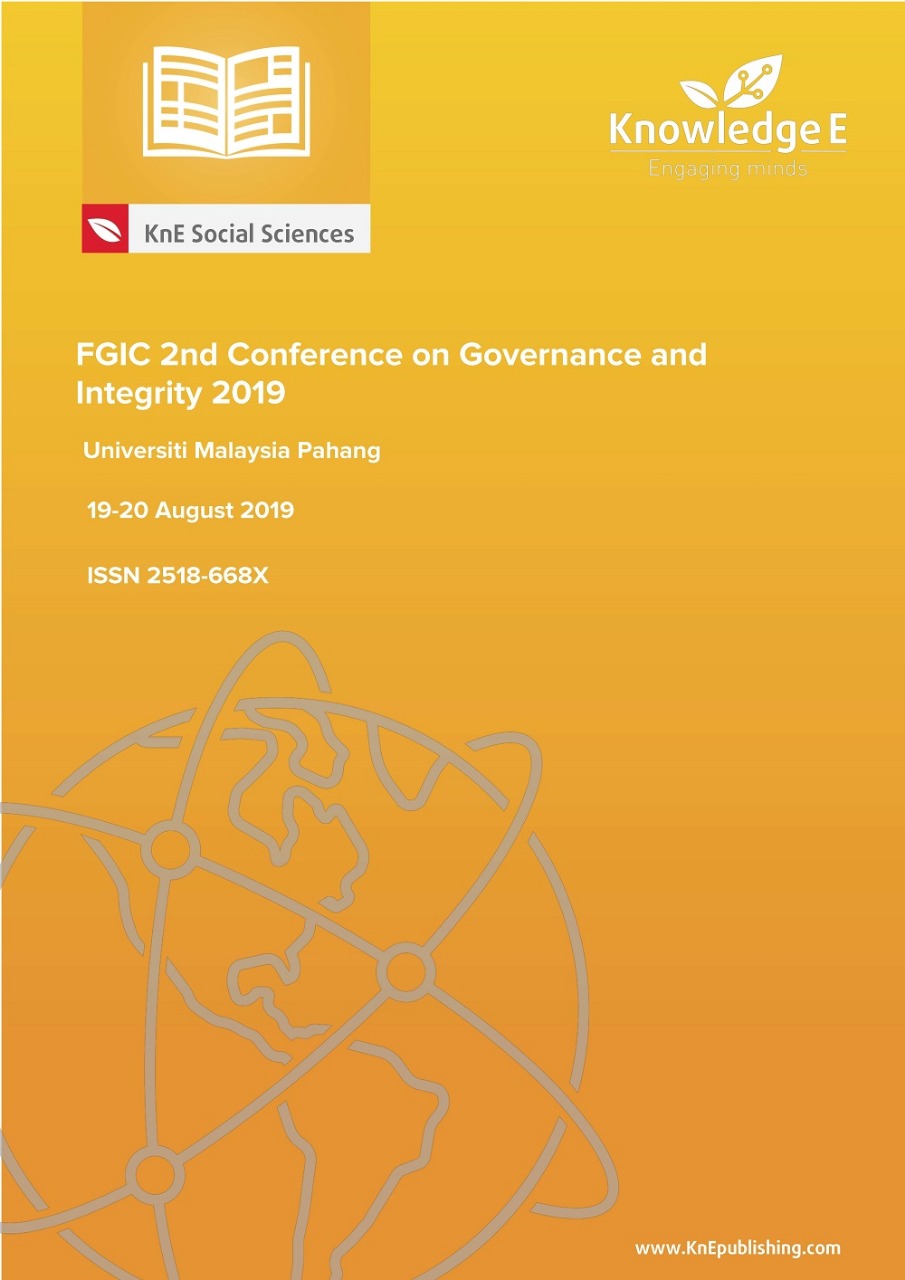A Systematic Review: Factors Affecting Employees’ Adoption of E-government Using an Integration of UTAUT & TTF Theories
DOI:
https://doi.org/10.18502/kss.v3i22.5044Abstract
Information and communication technologies (ICT) have been implemented mainly in government organizations, where e-government has become prevalent. The previous research focuses mostly on e-government adoption from the perspective of citizens. However, there is a scarcity of research conducted from the viewpoint of the employee. This study tried to identify and predict the factors that influence an employee to adopt technology implemented at the workplace by focusing on acceptance technology theories. The unified theory of acceptance and usage of technology (UTAUT) and Task-technology fit (TTF) using relevant findings in this review. The attempt to conduct a comprehensive explanation and analysis of the existing literature up to 2018, to understand the current situation of e-government implementation. Reviewing procedures were done by reviewing articles on e-government and related work by using indexing databases “web of science & Scopus. Finally, the results of this paper are the factors that make employees directly or indirectly adopt e-government.
References
Ajzen, I, & Fishbein, M. (1975). Understanding attitudes and predicting social behaviour. Retrieved from http://www.citeulike.org/group/38/article/235626
Ajzen, Icek. (1985). Behavioural Interventions Based on the Theory of Planned Behavior. Action Control, 11–39. https://doi.org/10.1007/978-3-642-69746-3_2
Al-Mutairi, A., Naser, K., & Fayez, F. (2018). Obstacles toward Adopting Electronic Government in An Emerging Economy: Evidence from Kuwait. Asian Economic and Financial Review, 8(6), 832–842. https://doi.org/10.18488/journal.aefr.2018.86.832. 842
Al-nidawi, W. J. A., Al-wassiti, S. kamil J., Maan, M. A., & Othman, M. (2018). A Review in E-government Service Quality Measurement. Indonesian Journal of Electrical Engineering and Computer Science, 10(3), 1257–1265. https://doi.org/10.11591/ijeecs. v10.i3.pp1257-1265
Alkhatib, H. (2013). E-Government Systems Success and User Acceptance in Developing Countries: The Role of Perceived Support Quality.
Almarabeh, T., & Abuali, A. (2010). A General Framework for E-Government: Definition Maturity Challenges, Opportunities, and Success. European Journal of Scientific Research, 39(1), 1450–216. Retrieved from http://www.eurojournals.com/ejsr.htm
Bakker, A. B. (2018). Multiple Levels in Job Demands-Resources Theory: Implications for Employee Well-being and Performance. Rotterdam, The Netherland,
Bandura, A. (1986). Social foundation of thought and action: A social-cognitive view. NJ: Prentice Hall.
Davis, F. D. (1986). A technology acceptance model for empirically testing new enduser information systems: Theory and results. Management, PhD (April), 291. https: //doi.org/oclc/56932490
Dewa, M., Zlotnikova, I., & Science, C. (2014). Citizens ’ Readiness for e-Government Services in Tanzania, 3(4), 37–45.
El-dosuky, M., & El-adl, G. H. (2019). GIZAChain: e-Government Interoperability Zone Alignment, based on blockchain technology. PeerJ Preprints, 2.
Goodhue, D. L., & Thompson, R. L. (1995). Task-Technology Fit and Individual Performance. MIS Quarterly, 19(2), 213. https://doi.org/10.2307/249689.
Greenland, A. (2019). Teachers’ Perspectives on Using Information and Communications Technology (ICT) to Improve Reading Comprehension: A Qualitative Study. Northcentral University.
Joshi, P. R., & Islam, S. (2018). E-Government Maturity Model for Sustainable EGovernment Services from the Perspective of Developing Countries. Sustainability, 10(6), 1882. https://doi.org/10.3390/su10061882.
Lai, P. C. (2017). The Literature Review of Technology Adoption Models and Theories for the Novelty Technology, 14(1), 21–38. https://doi.org/10.4301/S1807- 17752017000100002
Moore, G., & Benbasat, I. (1991). Development of an Instrument to Measure the Perceptions of Adopting an Information Technology Innovation. Information Systems Research. https://doi.org/10.1287/isre.2.3.192.
Mosweu, O., & Bwalya, K. J. (2018). A multivariate analysis of the determinants for adoption and use of the Document Workflow Management System in Botswana ’ s public sector, 84(2), 27–38. https://doi.org/10.7553/84-2-1767
Nanos, I., Manthou, V., & Androutsou, E. (2019). Cloud Computing Adoption Decision in E-government. Operational Research in the Digital Era–ICT Challenges, 125–145.
Rogers, E. (1995). Diffusion of Innovations.
Tarhini, A., El-Masri, M., Ali, M., & Serrano, A. (2016). Extending the UTAUT model to understand the customers’ acceptance and use of internet banking in Lebanon. Information Technology & People, 29(4), 830–849. https://doi.org/10.1108/ITP-02- 2014-0034
Taylor, S., & Todd, P. A. (1995). Understanding information technology usage: A test of competing models. Information Systems Research. https://doi.org/10.1287/isre.6. 2.144
Thompson, R., Higgins, C., & Howell, J. (1991). Personal computing: toward a conceptual model of utilisation. MIS Quarterly, 1991. Retrieved from http://www.jstor. org/stable/249443
Vallerand, R. J. (2000). Deci and Ryan’s Self-Determination Theory: A View from the Hierarchical Model of Intrinsic and Extrinsic Motivation. Retrieved from http: //www.er.uqam.ca/nobel/r26710/LRCS/publicat_en.htm#
Venkatesh, Morris, M. G., Davis, G. B., & Davis, F. D. (2003). User acceptance of information technology: Toward a unified view. MIS Quarterly, 27(3), 425–478. https: //doi.org/10.2307/30036540
Venkatesh, Thong, J. Y., & Xu, X. (2012). Consumer Acceptance and Use of Information Technology: Extending the Unified Theory of Acceptance and Use of Technology. MIS Quarterly, 36(1), 157–178. https://doi.org/10.1111/j.1540-4560.1981. tb02627.x
Venkatesh, V., & Davis, F. D. (2000). A Theoretical Extension of the Technology Acceptance Model: Four Longitudinal Field Studies, 46(2), 186–204.
Wang, Y. S. & Liao, Y. W. (2008). Assessing eGovernment systems success: A validation of the DeLone and McLean model of information systems success. Government Information Quarterly, 25(4), 717–733. https://doi.org/10.1016/j.giq. 2007.06.002
World Bank. (2015). e-Government. Retrieved from www.worldbank.org/en/topic/ict/ brief/e-government
Xing, Z. (2018). The impacts of Information and Communications Technology (ICT) and E-commerce on bilateral trade flows. International Economics and Economic Policy, 15(3), 565–586.
Yadav, K., & Tiwari, S. (2014). E-Governance in India: Opportunities and Challenges, 4(6), 675–680.

